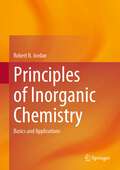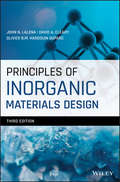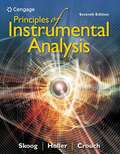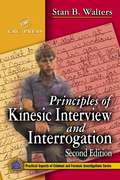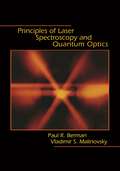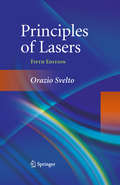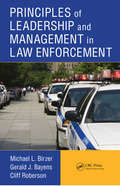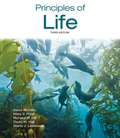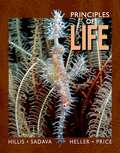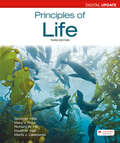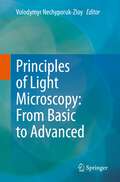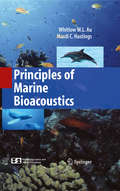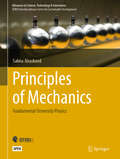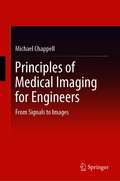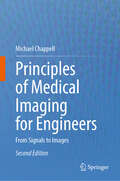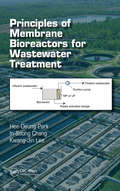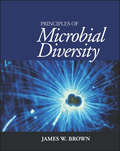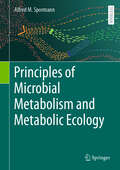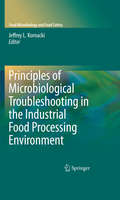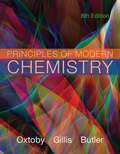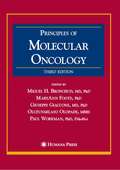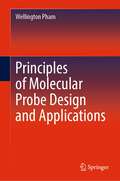- Table View
- List View
Principles of Inorganic Chemistry: Basics and Applications
by Robert B. JordanThis textbook provides a current and comprehensive coverage of all major topics of inorganic chemistry in a single source. It includes an analysis of the sources and preparations of the elements, their common compounds, their aqueous speciation, and their applications, while it also discusses reaction pathways and mechanisms. It includes up-to-date material, supported by over 4000 references to the original literature and to recent reviews that provide more detailed information. The material is accompanied by over 250 figures and three-dimensional representations, based on published structural details. Each chapter has worked examples and problems, with multiple inserts describing topical issues related to the material in the text. The textbook provides the instructor with a wide range of areas that can be selected to meet the background and interests of the students, while selected chapters are relevant to courses on more specialized topics, such as inorganic materials, bioinorganic chemistry, and nanomaterials. The intended readers are students, lecturers, and researchers who need a source for the current status of the area.
Principles of Inorganic Materials Design (Wiley Custom Select Ser.)
by John N. Lalena David A. Cleary Olivier B.M. Hardouin DuparcLearn the fundamentals of materials design with this all-inclusive approach to the basics in the field Study of materials science is an important aspect of curricula at universities worldwide. This text is designed to serve students at a fundamental level, positioning materials design as an essential aspect of the study of electronics, medicine, and energy storage. Now in its 3rd edition, Principles of Inorganic Materials Design is an introduction to relevant topics including inorganic materials structure/property relations and material behaviors. The new edition now includes chapters on computational materials science, intermetallic compounds, and covalent compounds. The text is meant to aid students in their studies by providing additional tools to study the key concepts and understand recent developments in materials research. In addition to the many topics covered, the textbook includes: • Accessible learning tools to help students better understand key concepts • Updated content including case studies and new information on computational materials science • Practical end-of-chapter exercises to assist students with the learning of the material • Short biographies introducing pioneers in the field of inorganic materials science For undergraduates just learning the material or professionals looking to brush up on their knowledge of current materials design information, this text covers a wide range of concepts, research, and topics to help round out their education. The foreword to the first edition was written by the 2019 Chemistry Nobel laureate Prof. John B. Goodenough.
Principles of Instrumental Analysis
by Douglas A. Skoog F. James Holler Stanley R. CrouchPRINCIPLES OF INSTRUMENTAL ANALYSIS, 7th Edition, places an emphasis on operating principles of each type of instrument, its optimal area of application, its sensitivity, its precision, and its limitations. You'll also learn about elementary analog and digital electronics, computers, and the treatment of analytical data.
Principles of Kinesic Interview and Interrogation (ISSN)
by Stan B. WaltersHow do you interpret a person‘s behavior during their interview? Some people say it‘s an innate quality that can‘t be taught. But anyone who‘s read Stan Walters Principles of Kinesic Interview and Interrogation knows that is FALSE. The overwhelming success of the first edition and the numerous success stories credited to the book prove that
Principles of Laser Spectroscopy and Quantum Optics
by Paul R. Berman Vladimir S. MalinovskyPrinciples of Laser Spectroscopy and Quantum Optics is an essential textbook for graduate students studying the interaction of optical fields with atoms. It also serves as an ideal reference text for researchers working in the fields of laser spectroscopy and quantum optics. The book provides a rigorous introduction to the prototypical problems of radiation fields interacting with two- and three-level atomic systems. It examines the interaction of radiation with both atomic vapors and condensed matter systems, the density matrix and the Bloch vector, and applications involving linear absorption and saturation spectroscopy. Other topics include hole burning, dark states, slow light, and coherent transient spectroscopy, as well as atom optics and atom interferometry. In the second half of the text, the authors consider applications in which the radiation field is quantized. Topics include spontaneous decay, optical pumping, sub-Doppler laser cooling, the Heisenberg equations of motion for atomic and field operators, and light scattering by atoms in both weak and strong external fields. The concluding chapter offers methods for creating entangled and spin-squeezed states of matter. Instructors can create a one-semester course based on this book by combining the introductory chapters with a selection of the more advanced material. A solutions manual is available to teachers. Rigorous introduction to the interaction of optical fields with atoms Applications include linear and nonlinear spectroscopy, dark states, and slow light Extensive chapter on atom optics and atom interferometry Conclusion explores entangled and spin-squeezed states of matter Solutions manual (available only to teachers)
Principles of Lasers
by Orazio SveltoThis new Fifth Edition of Principles of Lasers incorporates corrections to the previous edition. The text's essential mission remains the same: to provide a wide-ranging yet unified description of laser behavior, physics, technology, and current applications. Dr. Svelto emphasizes the physical rather than the mathematical aspects of lasers, and presents the subject in the simplest terms compatible with a correct physical understanding.
Principles of Leadership and Management in Law Enforcement
by Cliff Roberson Michael L. Birzer Gerald J. BayensEffective police organizations are run with sound leadership and management strategies that take into account the myriad of challenges that confront today‘s law enforcement professionals. Principles of Leadership and Management in Law Enforcement is a comprehensive and accessible textbook exploring critical issues of leadership within police agenci
Principles of Life
by David Sadava David Hillis Richard Hill Mary PriceFor instructors concerned that the practical skills of biology are lost when the student moves on to the next course or takes their first step into the “real world,” Principles of Life 3e lays the foundation for later courses and for students’ careers. Expanding on its pioneering concept-driven approach, experimental data-driven exercises, and active learning focus, PoL 3e introduces features designed to involve students in mastering concepts and becoming skillful at solving biological problems. Research shows that when students engage with a course, it leads to better outcomes. Principles of Life 3e is a holistic solution that has been designed from the ground up to actively engage students in mastering concepts and becoming skilled at solving biological problems. Within LaunchPad, our digital teaching and learning solution, we provide thoughtfully curated assignments and activities to support pre-lecture preparation, classroom activities, and post-lecture assessment. With its focus on key competencies foundational to biology education and careers, self-guided adaptive learning, and unparalleled instructor resources for active classrooms, Principles of Life is the resource students need to succeed.
Principles of Life
by David Sadava H. Craig Heller David M. Hillis Mary V. PriceFor sample chapters, a video interview with David Hillis, and more information, visitwww. whfreeman. com/hillispreview. Sinauer Associates and W. H. Freeman are proud to introducePrinciples of Life. Written in the spirit of the reform movement that is reinvigorating the introductory majors course,Principles of Lifecuts through the thicket of excessive detail and factual minutiae to focus on what matters most in the study of biology today. Students explore the most essential biological ideas and information in the context of the field’s defining experiments, and are actively engaged in analyzing research data. The result is a textbook that is hundreds of pages shorter (and significantly less expensive) than the current majors introductory books.
Principles of Life
by David Sadava H. Craig Heller David M. Hillis Mary V. PricePrinciples of Life is intended for an active learning approach to understanding the fundamental concepts of biology and serves as a textbook for instructors who are changing the way they teach biology to college undergraduates. Each chapter of Principles of Life is organized into a series of concepts that are important for mastering introductory biology.
Principles of Life Digital Update: For The Ap® Course
by David Hillis David Hall Richard Hill Mary Price Marta Laskowski Lauren O'ConnellPOL helps you build the skills and understanding you’ll need to succeed in the intro biology course, and give you a solid foundation for subsequent science courses as well. This version of the text is matched up with Macmillan Learning’s breakthrough online platform, Achieve.
Principles of Life: For the AP* Course (Second Edition)
by David Sadava David M. Hillis Mary V. Price Richard W. HillAP® Biology is rigorous and challenging, but Principles of Life helps lighten the load with one-of-a-kind resources for students and teachers. The foundation of the POL 2e program is a brief text that models the intent of the AP® redesigned course with more depth, less breadth, and a greater focus on concepts and applications. To help students with this often intimidating course, we created LearningCurve -- a game-like adaptive quizzing system that provides formative assessment in a friendly, low-stakes environment. And to ease the stress of planning and grading, we created a full, wrap-around Teacher's Edition. Therein, experts in AP® Biology offer point-of-use, in-the-margin teaching tips such as "Doing" Science, AP® Exam Tips, Mini-Labs, Common Misconceptions, Science Literacy, and more. An answer key and connections to the AP® Curriculum Framework round out this valuable tool.
Principles of Light Microscopy: From Basic to Advanced
by Volodymyr Nechyporuk-ZloyThis textbook is an excellent guide to microscopy for students and scientists, who use microscopy as one of their primary research and analysis tool in the laboratory. The book covers key microscopy principles and explains the various techniques such as epifluorescence microscopy, confocal/live cell imaging, SIM/light sheet microscopy, and many more. Easy-to-understand protocols provide helpful guidance for practical implementation in various commercially available imaging systems. The reader is introduced to histology and further be guided through advanced image acquisition, classification and analysis. The book is written by experienced imaging specialists from the UK, other EU countries, the US and Asia, and is based on advanced training courses for master students and PhD students. Readers are not expected to be familiar with imaging and microscopy technologies, but are introduced to the subject step by step. This textbook is indented for biomedical and medical students, as well as scientists and postdocs who want to acquire a thorough knowledge of microscopy, or gain a comprehensive overview of modern microscopy techniques used in various research laboratories and imaging facilities.Chapter 4 is available open access under a Creative Commons Attribution 4.0 International License via link.springer.com.
Principles of Magnetostatics
by Richard C. FernowThe subject of magnetostatics - the mathematical theory that describes the forces and fields resulting from the steady flow of electrical currents - has a long history. By capturing the basic concepts, and building towards the computation of magnetic fields, this book is a self-contained discussion of the major subjects in magnetostatics. Overviews of Maxwell's equations, the Poisson equation, and boundary value problems pave the way for dealing with fields from transverse, axial and periodic magnetic arrangements and assemblies of permanent magnets. Examples from accelerator and beam physics give up-to-date context to the theory. Furthermore, both complex contour integration and numerical techniques (including finite difference, finite element, and integral equation methods) for calculating magnetic fields are discussed in detail with plentiful examples. Both theoretical and practical information on carefully selected topics make this a one-stop reference for magnet designers, as well as for physics and electrical engineering undergraduate students.
Principles of Marine Bioacoustics
by Whitlow W. Au Mardi C. HastingsThis book is about studying the acoustics of marine animals using underwater acoustic techniques. Marine bioacoustics is a very broad interdisciplinary field that covers diverse areas as the production and reception of sound by researchers, the production and reception of sound by marine animals, the nature of sound propagation in the ocean, the nature of sound propagation in small tanks and other enclosure, signal processing techniques to acquire and store acoustic signals either on tape or in a computer, the analysis of sounds produced by marine animals, the characterization of hearing and sound production by marine animals, psycho-acoustic testing procedures, electrophysiological measurement procedures to name a few. Therefore, an accomplished bioacoustician must have some knowledge not only in the physics and mathematics of sounds but in the various areas mentioned above. This book attempts to discuss and unite the various areas of marine bioacoustics in a single text in as comprehensive manner possible.
Principles of Mechanics: Fundamental University Physics (Advances in Science, Technology & Innovation)
by Salma AlrasheedThis open access textbook takes the reader step-by-step through the concepts of mechanics in a clear and detailed manner. Mechanics is considered to be the core of physics, where a deep understanding of the concepts is essential in understanding all branches of physics. Many proofs and examples are included to help the reader grasp the fundamentals fully, paving the way to deal with more advanced topics. After solving all of the examples, the reader will have gained a solid foundation in mechanics and the skills to apply the concepts in a variety of situations.The book is useful for undergraduate students majoring in physics and other science and engineering disciplines. It can also be used as a reference for more advanced levels.
Principles of Medical Imaging for Engineers: From Signals to Images
by Michael ChappellThis introduction to medical imaging introduces all of the major medical imaging techniques in wide use in both medical practice and medical research, including Computed Tomography, Ultrasound, Positron Emission Tomography, Single Photon Emission Tomography and Magnetic Resonance Imaging. Principles of Medical Imaging for Engineers introduces fundamental concepts related to why we image and what we are seeking to achieve to get good images, such as the meaning of ‘contrast’ in the context of medical imaging. This introductory text separates the principles by which ‘signals’ are generated and the subsequent ‘reconstruction’ processes, to help illustrate that these are separate concepts and also highlight areas in which apparently different medical imaging methods share common theoretical principles. Exercises are provided in every chapter, so the student reader can test their knowledge and check against worked solutions and examples.The text considers firstly the underlying physical principles by which information about tissues within the body can be extracted in the form of signals, considering the major principles used: transmission, reflection, emission and resonance. Then, it goes on to explain how these signals can be converted into images, i.e., full 3D volumes, where appropriate showing how common methods of ‘reconstruction’ are shared by some imaging methods despite relying on different physics to generate the ‘signals’. Finally, it examines how medical imaging can be used to generate more than just pictures, but genuine quantitative measurements, and increasingly measurements of physiological processes, at every point within the 3D volume by methods such as the use of tracers and advanced dynamic acquisitions. Principles of Medical Imaging for Engineers will be of use to engineering and physical science students and graduate students with an interest in biomedical engineering, and to their lecturers.
Principles of Medical Imaging for Engineers: From Signals to Images
by Michael ChappellThis textbook is a concise introduction to medical imaging aimed at physical scientists and engineers, including budding biomedical engineers and biophysicists. The book introduces fundamental concepts related to how we "see" inside the body using medical imaging technology and what is needed to obtain useful images. The text first considers the underlying physical principles by which information about tissues within the body can be extracted in the form of signals, examining the major principles used: transmission, reflection, emission, and resonance. It then explains how these signals can be converted into images, i.e., full 3D volumes, demonstrating how common methods of "reconstruction" are shared by some imaging techniques, despite relying on different physics to generate the "signals." Finally, it explores how medical imaging can be used to generate more than just pictures, but genuine quantitative measurements, and increasingly, measurements of physiological processes at every point within the 3D volume using methods such as tracers and advanced dynamic acquisitions. Now in its second, fully updated and expanded edition, the textbook contains new sections on image analysis concepts, covers a wide range of techniques used to enhance and interpret medical imaging, and includes concise introductions to optimization and machine learning in their application to medical imaging . The second edition also includes expanded discussions on quantitative, functional, physiological, and metabolic imaging. 'Principles of Medical Imaging for Engineers&’ second edition will be invaluable to students and graduate students in engineering and physical sciences with an interest in biomedical engineering, as well as to their professors.
Principles of Membrane Bioreactors for Wastewater Treatment
by Hee-Deung Park In-Soung Chang Kwang-Jin LeeMembrane bioreactor (MBR) technology is a wastewater treatment method combining biological pollutant treatment with physical membrane separation. It has gained increasing commercial significance over the last decade, with applications in municipal and industrial wastewater treatment becoming increasingly widespread. This book covers a wide variety of MBR topics, including filtration theory, membrane materials and geometry, fouling phenomena and properties, and strategies for minimizing fouling. Also covered are practical aspects such as operation, maintenance, design, and application.
Principles of Microbial Diversity (ASM Books #43)
by James W. BrownEvery speck of dust, drop of water, and grain of soil and each part of every plant and animal contain their own worlds of microbes. Designed as a key text for upper-level undergraduates majoring in microbiology, genetics, or biology, Principles of Microbial Diversity provides a solid curriculum for students to explore the enormous range of biological diversity in the microbial world. Within these richly illustrated pages, author and professor James W. Brown provides a practical guide to microbial diversity from a phylogenetic perspective in which students learn to construct and interpret evolutionary trees from DNA sequences. He then offers a survey of the "tree of life" that establishes the necessary basic knowledge about the microbial world. Finally, the author draws the student's attention to the universe of microbial diversity with focused studies of the contributions that specific organisms make to the ecosystem. Principles of Microbial Diversity fills an empty niche in microbiology textbooks by providing an engaging, cutting-edge view of the "microbial zoo" that exists around us, covering bacteria, archaea, eukaryotes, and viruses.
Principles of Microbial Metabolism and Metabolic Ecology
by Alfred M. SpormannThis textbook examines the fundamental principles of microbial metabolism and how a microbe's ecology is intrinsically interwoven with and a consequence of its metabolism. Further, it answers many questions frequently asked by students, such as: What are the mechanistic connections between simple phenotypic traits, ecological patterns and microbial metabolism and diversity? In the process, readers will be introduced to essential topics like metabolism and metabolic pathways, flux of energy and nutrients, genome size and fitness, competition, selection and drift.Moreover, the book conveys fundamental principles that show students how to approach the field of microbiology from a different, more unifying angle, e.g., how microbes’ access to environmentally available energy resources and the specific metabolism involved lies at the root of every ecologically significant microbial speciation. This aspect, together with its special focus on metabolism and ecological implications, make the book a must-read for all students of microbiology.
Principles of Microbiological Troubleshooting in the Industrial Food Processing Environment
by Michael P. Doyle Jeffrey KornackiWritten with the in-plant food safety/quality assurance professional in mind, this reference offers proven approaches and suggestions for finding sources of microbiological contamination of industrially produced products.
Principles of Modern Chemistry
by David Oxtoby H. Gillis Laurie ButlerLong considered the standard for covering chemistry at a high level, PRINCIPLES OF MODERN CHEMISTRY continues to set the standard as the most modern, rigorous, and chemically and mathematically accurate book on the market. This authoritative text features an "atoms first" approach and thoroughly revised chapters on Quantum Mechanics and Molecular Structure (Chapter 6), Electrochemistry (Chapter 17), and Molecular Spectroscopy and Photochemistry (Chapter 20). In addition, the text utilizes mathematically accurate and artistic atomic and molecular orbital art, and is student friendly without compromising its rigor. End-of-chapter learning aids now focus on only the most important key objectives, equations and concepts, making it easier for readers to locate chapter content, while new applications to a wide range of disciplines, such as biology, chemical engineering, biochemistry, and medicine deepen readers' understanding of the relevance of chemistry in today's world.
Principles of Molecular Oncology
by Miguel H. Bronchud Maryann Foote K. Antman Giuseppe Giaccone Paul Workman Olufunmilayo I. OlopadeDrawing on years of significant advances and developments, the editors of this third edition have thoroughly updated the highly praised first and second editions and added new chapters to reflect the knowledge emerging from research on genomics, proteomics, chemoprevention strategies, pharmacogenomics, new molecular targets, therapeutic monoclonal antibodies, and innovative cytotoxic and cytostatic small molecular-weight molecules.
Principles of Molecular Probe Design and Applications
by Wellington PhamThis book describes insight mechanisms for designing molecular probes and methods that these agents can be used for medical diagnosis in preclinical animal models via optical, MRI and PET imaging. The book has a wealth of schemes of synthesis and methods deduced from pioneers in the field, making it possible to immerse into real-world molecular imaging. Written for graduate student training and practitioners, this book will serve as a teaching material and/or reference for anyone interested in exploring the power of chemical synthesis of imaging agents.
